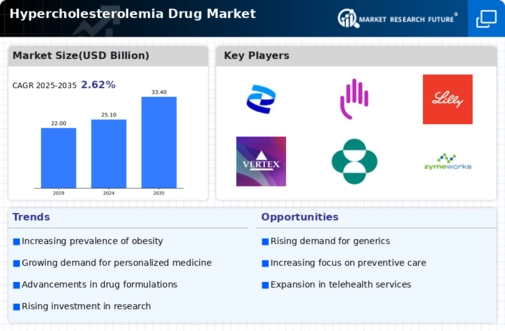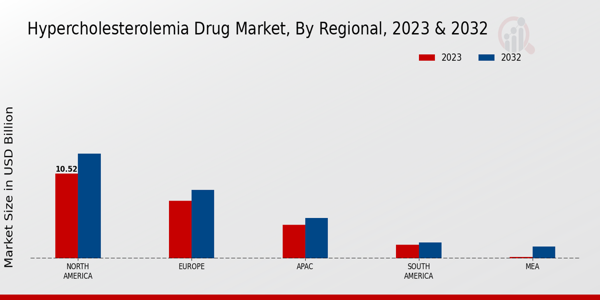Aging Population
The aging population is a significant factor influencing the Global Hypercholesterolemia Drug Market Industry. As individuals age, the risk of developing hypercholesterolemia increases, necessitating effective management strategies. The World Health Organization indicates that the global population aged 60 years and older is expected to reach 2.1 billion by 2050. This demographic shift is likely to result in a higher prevalence of cholesterol-related health issues, thereby driving demand for effective pharmacological interventions. The market's growth trajectory is closely linked to the healthcare needs of this aging cohort, emphasizing the importance of tailored treatment options.
Market Trends and Projections
Advancements in Drug Development
Innovations in drug development are significantly influencing the Global Hypercholesterolemia Drug Market Industry. Recent advancements in biotechnology and pharmacology have led to the introduction of novel therapeutic agents, including PCSK9 inhibitors and other targeted therapies. These drugs offer enhanced efficacy and safety profiles compared to traditional statins, appealing to both healthcare providers and patients. As a result, the market is expected to grow steadily, with projections indicating an increase to 33.4 USD Billion by 2035. This growth underscores the importance of ongoing research and development efforts in addressing the complexities of hypercholesterolemia.
Regulatory Support for New Therapies
Regulatory support for the approval of new therapies is a crucial driver for the Global Hypercholesterolemia Drug Market Industry. Regulatory agencies are increasingly recognizing the need for innovative treatments to address the growing burden of hypercholesterolemia. Streamlined approval processes and incentives for research and development are fostering an environment conducive to the introduction of new medications. This regulatory landscape not only encourages pharmaceutical companies to invest in novel therapies but also enhances patient access to effective treatments. As a result, the market is poised for growth, reflecting the ongoing commitment to improving cholesterol management.
Growing Awareness and Screening Programs
Increased awareness of hypercholesterolemia and the importance of cholesterol management is driving the Global Hypercholesterolemia Drug Market Industry. Public health initiatives and screening programs have been implemented to educate individuals about the risks associated with high cholesterol levels. These efforts encourage early diagnosis and treatment, leading to higher medication adherence rates. Consequently, the demand for cholesterol-lowering drugs is expected to rise, contributing to a projected compound annual growth rate (CAGR) of 2.62% from 2025 to 2035. This trend highlights the critical role of education in managing hypercholesterolemia effectively.
Rising Prevalence of Hypercholesterolemia
The increasing prevalence of hypercholesterolemia globally is a primary driver for the Global Hypercholesterolemia Drug Market Industry. As lifestyle-related diseases become more common, the number of individuals diagnosed with high cholesterol levels continues to rise. According to recent statistics, approximately 39% of adults aged 45 and older are affected by hypercholesterolemia. This growing patient population necessitates effective treatment options, thereby propelling the demand for cholesterol-lowering medications. The market is projected to reach 25.1 USD Billion in 2024, reflecting the urgent need for innovative therapies to manage this condition.














